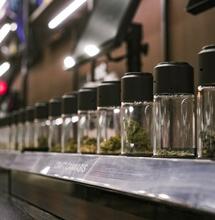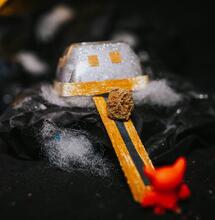How to Grow Northern Lights Cannabis?

Some cannabis strains are simply famous, but Northern Light? - It’s a legend among the legends. One advantage of cultivating this strain is, it’s relatively easy to grow. Several phenotypes circulate the market, so first and foremost, it’s crucial to find Northern Lights with good genetics. Read on to find out how to grow the best buds of NL.
If you enjoy cannabis as much as every experienced pothead does, the chances are you’ve, at some point during your bud tasting journey, probably had Northern Lights or some of its associated varieties. Northern Lights is an iconic name on the global weed scene. It’s a strain that has topped rare milestones in the modern history of cannabis.
Proof of that is that it has been rewarded with numerous accolades within the last four decades or so. The staple indica strain is linked to several continents, including North America, Europe, and Asia. In this article, get familiar with NL’s unordinary genetics lineage, and skim through valuable tips that can help you grow the most potent Northern Light plants with luscious buds and irresistible flavor.
What’s the Buzz with Northern Lights Genetics?
Its modern version is a genuine, heavenly made match with Afghani Indica and Thai Sativa, but the name of this classic strain may refer to at least a dozen different original NL plants. The general assumption is that Northern Lights originates from the Pacific Northwest region in the United States. It’s often thought that its place of origin is Washington state, although the strain genetics are linked to the Golden State sometime in the early 1970s.
Afghan seeds and Thai genetics were crossed a decade later in an attempt to enhance the strain, so it’s better adapted to an environment frequently affected by bleak wet weather. From the U.S., those early modified Northern Lights plants traveled overseas to the Netherlands, where the Seed Bank created a Dutch version of the strain, today sold by Sensi Seed Bank. Dutch growers grew the strain next to other vanguards, the likes of Skunk #1 and Original Haze.
While in the beginning Northern Lights accounted for a pure indica, its genetics changed with crossbreeding. Early original plants rarely surpassed four feet in height and were marveled at their broad fan leaves and ubiquitous green color. In the Netherlands, the legendary strain was excessively bred, and it was this mixing that resulted in wiggling its genes with some vigorous sativa. Of all Northern Lights that have succeeded, the Northern Lights #5 has been the most famous and most recognized one.
Number five has repeatedly won the High Times Cannabis Cup and has been voted the best Dutch strain of cannabis. Northern Lights #2, which has been crossbred with #5, has been hailed as another favorite. According to Sensi Seed Bank, Northern Lights’ genetics share only 10% sativa and as much as 90% indica. It usually takes between 45-50 days for Northern Lights phenotypes to flower, and its outdoor harvest time is from mid-to-late September.
The Canadian variant, known as Atomic Northern Lights after its creator Dr. Atomic, bumps a genetic mixture of 35% sativa and 65% indica. Atomic Northern Lights takes up to 50-65 days to flower and is usually harvested in mid-October. In this case, genuine Northern Lights plants were crossbred with Afghani landrace and Thai Haze ancestors.
All Northern Lights cannabis strains are praised for their strong psychedelic effect, characterized by intense, heady high with a hint of euphoria.
Is It Easy to Grow Northern Lights Cannabis?
It’s reasonably easy, yes. The average time the plants finish flowering is around eight weeks, and whether you use hydroponics for growing - it may shorten to six.
Northern Lights plants have compact, dense buds, which are relatively easy to trim. Tight and thick, but not impenetrable. A silvery-white layer of trichomes coats the buds, and the yield is admirable. NL buds can quickly adapt in humid environments, but you should still pay attention to protect buds from rotting.
Depending on which phenotype you grow, your NL plant might have a singular cola structure or a dense, compact central stalk accompanied by four or five lateral branches (indicative of NL #2 genetics).
If you’ve decided to grow the Northern Lights cannabis strain, it’s important to first find the best strains genetics out there.
Where to Find Northern Lights Seeds with Best Genetics?
You may be the most attentive marijuana grower in the room, but sometimes, if you don’t have the right seeds, the growing effort might fail miserably. Connect and network with other growers (via apps or growers’ platforms) and inquire if someone has Northern Lights with good genetics. Preferably, find seeds that will respond well to the local climate where you’ll be growing your Northern Lights plants.
If you take seeds from an experienced grower, the chances are they’ve already made efforts into creating a potent version of NL, which has already become resistant to fungus and pests. You also want to find seeds that mix both indica and sativa. A hybrid is always easier to grow, especially when growing inside. Alternatively, you can look for seeds online from sources such as Dinafem.
Should You Train Northern Lights Plants?
Whether you want to grow taller plants with beautifully defined colas, where each cola is receiving sufficient light and nutrients, plant training is recommended. Several methods work for Northern Lights plants. If you perform low-stress training (LST) on your NL plants, it will encourage the plant to extend its growth. With LST, you want to gently bend the stems, fixing them in a position without radically changing the plant’s shape.
If the NL plants appear to have too many leaves that prevent light and airflow from reaching the lower areas of the plant, you may consider defoliation, which is a type of high-stress training (HST). The major intervention here is removing excess leaves from the cannabis plant.
A common error with defoliation is growers identifying and removing foliage only in ailing plants. But that is not the point of the procedure. Defoliation should be performed on healthy plants. When performed on weak plants, it may make the plant even more vulnerable or cause it to die. So, defoliation should target healthy plants, in particular leaves that appear to shade other leaves. Reserve this method for indoor crops, and only if you are an experienced grower.
Another method that works miracles for Northern Lights plants is the Sea of Green (SOG). The idea with SOG is to grow several smaller cannabis plants instead of a few bigger ones.
Here are some basic SOG steps:
- Germinate seeds or make cuttings to create clones.
- Grow the seeds or cuttings into young plants using 18 to 24 hours of light.
- When plants grow to about 6 inches (around 25 centimeters), change to a 12-12 light regiment. This should speed up flowering.
- Make sure there’s sufficient space between each plant.
- Wait until the plants form dense canopies or after buds form, then trim the branches beneath and create clones from them.
- Harvest when you are ready and repeat the cycle.
With SOG, individual plants are less prominent and will grow fewer colas, but the grander idea here is to have a recurring harvest and faster harvest.
Novice growers are encouraged to stick with LST but refrain from trying HST, such as defoliation, which can kill the plants if done wrong. If you are a new grower, you may also want to wait for SOG until gaining some start experience from cultivating the first few plants, observing the process carefully, and learning from the mistakes you make.

Are Multiple Harvests Possible with Northern Lights Plants?
Yes, especially if you opt for the SOG method mentioned above. You can apply SOG both with soils and hydroponics, and in perfect case, you can accomplish several harvests during the year-round. One important thing is to play right with the lights. Expose your Northern Lights plants to plenty of sunshine. While you are encouraged to use indoor lights during the germination and vegetation of your plants, when the NL plants enter flowering time, try to switch to natural light.
If possible, you can go for indoor growing during the winter and pack the grow room with grow lights. Come spring, take the pots outside. If everything goes well, you can aim for as many as three annual harvests of Northern Lights. Bonus perk from using natural light whenever you can is reducing your electricity bill.
How to Optimize Grow Light for This Strain?
Basically, you need to shower your Northern Lights with light. During vegetation, NLs require extensive hours of light. While you are safe to go with at least 18 hours of light a day, you can also boost with a full cycle of light or keeping the lights on 24 hours non stop. Because NL plants demand so much access to light during vegetation, they are not the perfect candidate for outdoors growing during this stage. You can switch to 12-12 light cycles once the plants begin to flower. Or take them outside if the weather allows it. By flowering stage, your NL plants should grow pretty tall. Anticipate they are ready to yield in about 45 days of flowering.
Here’s how to organize an annual harvest calendar for Northern Lights:
- Have your plants ready and out by early March so you can pursue a first round of harvesting in late April
- Move the second round of plants in early April, so it’s ready for yield somewhere at the end of May
- Go for the third round and harvest at the end of June too
With a strain such as Northern Lights that demands excessive light exposure, it may be worrisome for some of you that it might reflect on the utility bill. But do it properly - the result is rewarding! A majority of growers choose High-Intensity Discharge (HID) lamps such as Metal Halide (MH) or High-Pressure Sodium (HPS). It’s good to note that with HPS lamps, Northern Lights plants may need an extra week to reach full maturation, but that can contribute to a more significant yield.
How to Nutrient Feed Northern Lights Plants?
Like other cannabis plants, Northern Lights need sufficient Nitrogen (N) levels in vegetation as well as sufficient Phosphorus (P) and Potassium (K) once it enters flowering time. Another good thing with Northern Light is that nitrogen burn chances are lower, as the strain can soak more Nitrogen than usual. Needless to say, those who’ve only recently started their grow-your-own journey should always stay cautious when feeding their cannabis. Plants will show signs whether you are overfeeding or underfeeding them. Yellowing leaves is a classic presentation, though other odd discolorations should also raise the alarm.
Northern Lights require utmost attention during the early stages when the plants are very young, and especially if you’ve supplied readily available nutrient solutions from the shop. Often these products are super packed with nutrients, more than what your plants may ask for. Carefully administer the amounts of nutrients, little by little, and see how the plant reacts to it. It’s never a good idea to overfeed the plants as that might be the perfect recipe to kill the plant.
Besides the N-P-K mix, Northern Lights plants may benefit from other micro-nutrients like Magnesium, Calcium, and Sulfur and a tinge of Copper, Iron, Zinc, Manganese, and Boron. All of these nutrients are contained in most nutrient mixes, but as already mentioned, it is good to be cautious about the dosages. If someone in your circle of friends is also growing NL ask them for the best practices and inquire how they manage plant nutrition.
What pH Balance to Stick with?
The generally accepted pH range for cannabis is somewhere between 6.0 and 7.0 for soils, and slightly less than that for hydroponics. For Northern Lights, try a pH range between 6.3 and 6.7. If you are unfamiliar with what pH is, here’s a good place on the internet to get the basic idea. Cannabis will typically suffer when its pH is not adjusted in the optimal range. While a 0.1 difference will not cause any harm, a more significant difference than that will do.
Using correct doses for nutrients in both soil and hydroponic setting is of great importance because it can affect the pH values. The pH value of each element is different. Novice growers should opt for growing cannabis in soils as there’s less likelihood that nutrient feeds will lead to any pH issues. Try hydroponics when you have some growing experience behind you.
Extra tip: Rainwater can help when the soil appears too alkaline. A thin crust of dolomite (a type of mineral) should help correct acidic soil. A less fancy solution is eggshells. For hydroponics, ensure the pH range is set between 5.5 and 6.5.
How to Monitor pH?
The simplest way to check pH in your growing medium is by using pH strips. When you dent the small litmus piece of paper into the medium, it’s designed to change color and indicate whether the medium is alkaline or acidic. Since you’ll repeatedly add water and/or nutrients to your crops, you’ll need to monitor pH levels continually. A digital device to measure pH would be most practical.
How Can You Prevent Garden Infestation?
Pests might always be after your cannabis plants, even when you are growing Northern Lights cannabis, a strain generally praised for its resilience to invaders. While cannabis plants have natural mechanisms to defend against pests, you should always support them with additional protection. The minimal effort you can do is maintain a clean growing setup. Sterilize the hydroponic system before you start growing. Wash your hands every time before you touch the plants. Handle hygiene for your plants the same way you would handle the food you eat.
Maintaining optimal humidity and temperature range is another critical step to ensure your plants stay safe indoors. Always filter the air, preferably with a high-quality household filter. For infestations such as with fungus gnats, you may need to use neem oil, which contains active ingredients like azadirachtin, which kills pests. Insecticidal soap will also eliminate any invader. In order to prevent infestations from recurring, you may need to reduce humidity in the grow room as fungus thrives in damp and dark places.
What else is good to know? Roots and seedlings are most vulnerable to infestations. But so there are chances for hazard with plants in advanced stage of growth. Disease can easily spread from one sickly plant to another, therefore, a fast reaction to get rid off pests and infestation is critical. Here’re some more tips on dealing with some of the most common pests known to invade cannabis plants. Always try to use natural solutions to ward off the pests.
What Is the Ideal Temperature + Humidity Setup for NL?
Northern Lights crops thrive in warm weather, ideally where the summer is hot and steamy. When grown indoors, the indica-dominant hybrid requires a temperature around 80°F (or around 27°C). Five degrees plus or minus from this parameter are tolerable for NL plants, although, during the flowering stage, it’s best not to surpass the 80°F margin. During nighttime, plants should anyway be kept at lower temperatures than during daytime, but ensure that the difference is no greater than 10 degrees Fahrenheit (or five degrees Celsius). On a side note, grow lights will efficiently generate excess heat in the room, so implement a solution that can vent out the extra hot air and circulate some cold air in the grow room as needed.
Whatever you do, remember that Northern Lights cannot sustain temperatures greater than 85°F (or around 29°C). Adding extra CO2 in the grow room can help utilize excess energy and prevent raising the temperature. For infestations, avoid significant temperature drops such as the above mentioned difference 10 degrees Fahrenheit difference (or five degrees Celsius).
Finally, keep humidity levels above 60% when the NL plants are still young and vegetating. Once they begin to flower, start to decrease humidity levels by 5% each week. At the same time, lower the temperature gradually. That can boost the formation of luscious buds for your NL plants. A high-quality thermometer and humidity monitoring unit may benefit well in case you are growing a more significant number of Northern Lights plants.
Regulating humidity and room warmth is also critical when you proceed to dry and cure the plant’s plucked buds. Keep the freshly harvested buds at temperature around 65°F (18°C) and humidity range between 45%-55%. When your Northern Lights buds are ready, it’s time to taste them!
What Are the Effects from Using Northern Lights Weed?
Northern lights, one of the most popular indica strains of all times, is well received among growers, medical patients, and recreational users alike. Anticipate a nice cerebral high with a hint of euphoria. The pungent sweet and spicy flavor of the strain is a bonus in the entire experience. Its medical qualities can help counteract depression, anxiety and stimulate the appetite. The strain is also commonly used for insomnia and pain as it helps release tension in the body and muscles and induce deep sleep. While some strain varieties contain as much as 27% of THC, others may have as little as 12%. If you are not a grower, but still want to try Northern Lights, look for it at nearby dispensaries. If you are ready to grow it, follow the directions in this article and reach out with comments to summon community help. Happy growing!
More grow guides from Soft Secrets:







